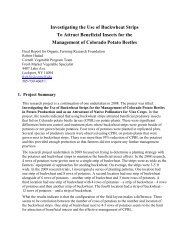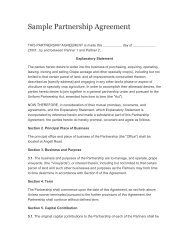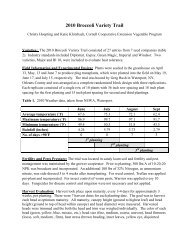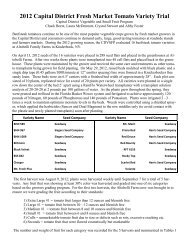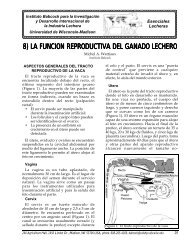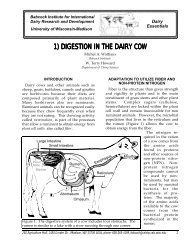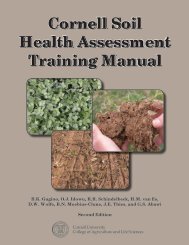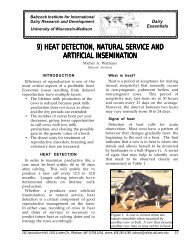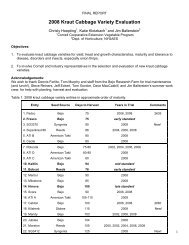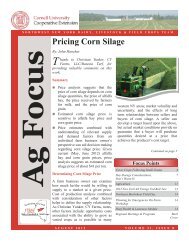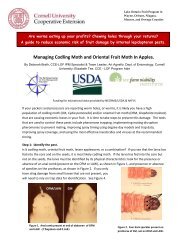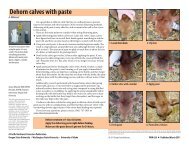Growing Onions in a Minimum Tillage System Provides Superior ...
Growing Onions in a Minimum Tillage System Provides Superior ...
Growing Onions in a Minimum Tillage System Provides Superior ...
Create successful ePaper yourself
Turn your PDF publications into a flip-book with our unique Google optimized e-Paper software.
Apply fertilizer <strong>in</strong> the spr<strong>in</strong>g: In the first year of study, <strong>in</strong> the m<strong>in</strong>imum tillage systems, the full rates ofrequired phosphorous (P) and potassium (K) accord<strong>in</strong>g to a soil test, and 56 lb/A of nitrogen (N) wereapplied <strong>in</strong> the fall and <strong>in</strong>corporated prior to plant<strong>in</strong>g the cover crops. In the spr<strong>in</strong>g, 5 gal/A of 6‐24‐6NPK pop‐up fertilizer was applied <strong>in</strong> the furrow at seed<strong>in</strong>g and 100 lb/A of sulfur coated urea (46‐0‐0)was broadcast at the first and forth leaf onion stages for a total of 151 lb/A of applied N. Sulfur‐coatedurea was used to m<strong>in</strong>imize loss of N until it could be ra<strong>in</strong>ed <strong>in</strong> naturally, as the grower cooperator didnot have the ability to irrigate.Prior to plant<strong>in</strong>g <strong>in</strong> the spr<strong>in</strong>g, soil test results showed that levels of P were low <strong>in</strong> the m<strong>in</strong>imum tillagesystems, which suggested that 35 to 47% of the P applied <strong>in</strong> the fall was lost over w<strong>in</strong>ter. Soil levels ofavailable N were low or very low throughout the spr<strong>in</strong>g. Even on June 19 at the 4 leaf stage, just 6 daysafter the second side‐dress application of N, the m<strong>in</strong>imum tillage oat and wheat systems had one‐thirdand one‐half, respectively, of the available N <strong>in</strong> the conventional system (74 lb/A N). Soil tests were nottaken later than June 19 <strong>in</strong> this study. Leaf tissue analysis on July 22 showed that the level of nitrogen <strong>in</strong>the onions grown <strong>in</strong> the m<strong>in</strong>imum tillage wheat system was high <strong>in</strong>dicat<strong>in</strong>g that nitrogen <strong>in</strong> the soil didnot rema<strong>in</strong> low throughout the grow<strong>in</strong>g season. However, tissue levels of N <strong>in</strong> the onions <strong>in</strong> them<strong>in</strong>imum tillage oats system were lower and the onion plants were visibly lighter green than thosegrown <strong>in</strong> the conventional and m<strong>in</strong>imum tillage wheat systems.To improve the efficiency of fertilizer use <strong>in</strong> the m<strong>in</strong>imum tillage systems, <strong>in</strong> the second study, <strong>in</strong> thespr<strong>in</strong>g, the full rates of required P and K accord<strong>in</strong>g to a spr<strong>in</strong>g soil test and 75 lb/A N were appliedbroadcast and <strong>in</strong>corporated 1‐2 <strong>in</strong>ches us<strong>in</strong>g a multivator precisely between the cover crop rows, oneday before the onions were seeded (Table 1). Aga<strong>in</strong>, 5 gal/A of 6‐24‐6 NPK pop‐up fertilizer was applied<strong>in</strong>‐furrow at plant<strong>in</strong>g and a side dress application of 100 lb of urea was made at the 5 leaf stage for atotal of 126 lb/A N. In this trial, the same rates of fertilizer were applied to both the conventional andm<strong>in</strong>imum tillage systems.In this study, levels of N and P were significantly higher <strong>in</strong> the m<strong>in</strong>imum tillage systems compared to theconventional (Table 2). The levels of P and N <strong>in</strong> the conventional system were lower <strong>in</strong> 2011 than theywere <strong>in</strong> 2008, which may have been due to issues associated with the very cool and wet spr<strong>in</strong>g. In them<strong>in</strong>imum tillage systems, apply<strong>in</strong>g P and N <strong>in</strong> the spr<strong>in</strong>g resulted <strong>in</strong> sufficient levels of these nutrients,which were double the levels achieved <strong>in</strong> the 2008 study. Clearly, apply<strong>in</strong>g the full rate of NPK <strong>in</strong> thespr<strong>in</strong>g broadcast and shallow cultivat<strong>in</strong>g it <strong>in</strong> precisely between the onion rows was an effective andefficient strategy for apply<strong>in</strong>g NPK to onions grown <strong>in</strong> a m<strong>in</strong>imum tillage system.Nutrient dynamics <strong>in</strong> m<strong>in</strong>imum tillage systems: It was estimated based on the amount of cover cropresidue <strong>in</strong> the m<strong>in</strong>imum tillage systems <strong>in</strong> mid‐May that the decomposition of the cover crop residuesprovided 20 to 25 lb/A of N to the soil, some of which could be taken up by the onion crop. Because thesoil levels of P were also significantly higher <strong>in</strong> the m<strong>in</strong>imum tillage systems than the conventional <strong>in</strong>2011, despite all systems receiv<strong>in</strong>g the same amount of NPK at the same time, this suggested that eitherP was m<strong>in</strong>eralized from the decompos<strong>in</strong>g cover crops, or that the cover crops <strong>in</strong> the m<strong>in</strong>imum tillagesystems reta<strong>in</strong>ed the P better than the conventional dur<strong>in</strong>g the cool and wet May and June, or thatthere was a difference between fertilizer application techniques. Perhaps there is greater nutrientuptake <strong>in</strong> the m<strong>in</strong>imum tillage systems, because the nutrients were concentrated <strong>in</strong> a shallower layerdue to the <strong>in</strong>ter‐row NPK <strong>in</strong>corporation with cultivation to 1‐2 <strong>in</strong>ches compared to the conventionalsystems where cultivation was to 4 <strong>in</strong>ches. To further support this theory, soil levels of P tended tomimic those of N. Alternatively, when N and P are m<strong>in</strong>eralized via decomposition of cover crops, they3



